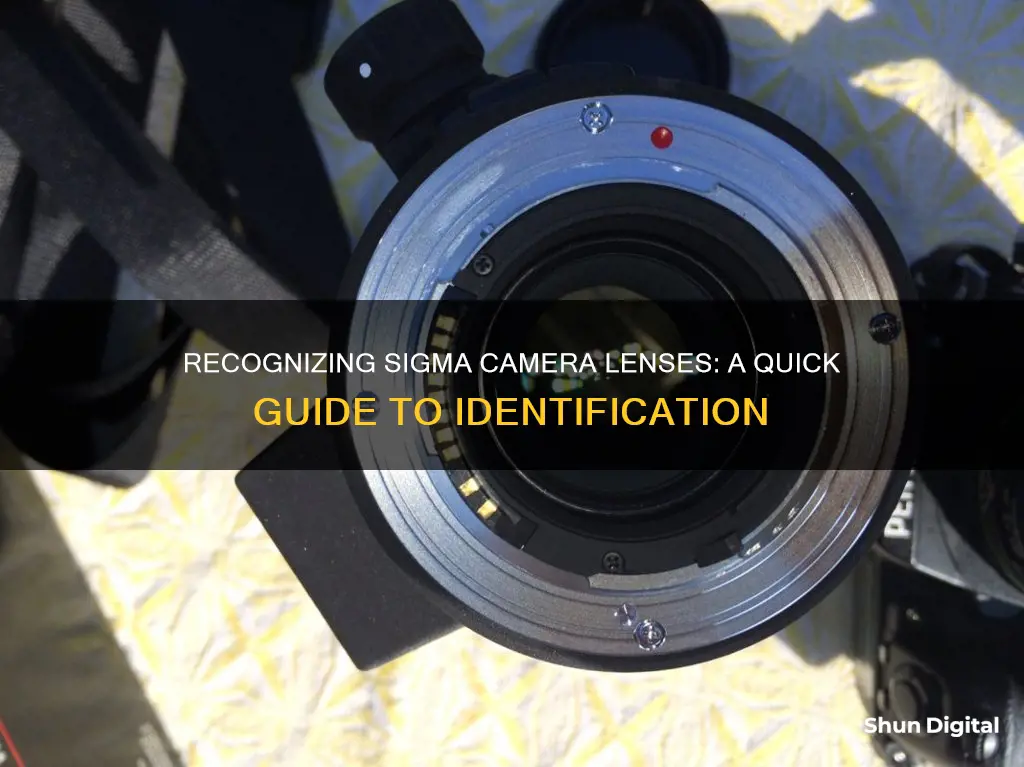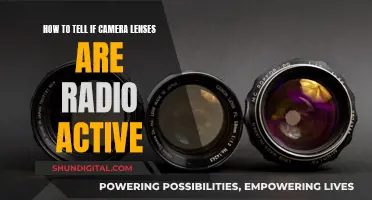
Sigma lenses are used by many top photographers worldwide. The company manufactures lenses for various camera brands, including Canon, Sony, and Nikon mounts. Sigma lenses are designed to fit the most popular mounting systems available today. Sigma lenses are divided into three product lines: Contemporary, Art, and Sports. The Contemporary line combines optical performance with compactness, the Art line focuses on sophisticated optical performance, and the Sports line offers high action-capture performance. Sigma lenses are also categorized by type, including fisheye, macro, wide-angle, standard, and telephoto.
What You'll Learn

Lens mount type
Sigma lenses are available in a variety of lens mounts, including Canon EF, Nikon F, Sony E, and more. Each camera brand has its own lens mount system, and Sigma produces lenses that are compatible with multiple brands. Therefore, it is essential to ensure that the lens mount matches your camera brand.
Sigma lenses are designed for both mirrorless and DSLR cameras, with specific lenses tailored for each type. For mirrorless cameras, Sigma offers lenses in Sony E-Mount, Fujifilm X-Mount, Nikon Z-Mount, Canon EF-M, Micro Four Thirds, and their own L-Mount. These lenses are denoted by "DN" in the lens name, indicating they are designed exclusively for mirrorless cameras.
For DSLRs, Sigma lenses are available in Canon EF and Nikon F mounts. These lenses are denoted by "DG" or "DC" in the lens name, indicating full-frame or crop sensor coverage, respectively. It is important to note that DC format lenses can technically be mounted on full-frame DSLRs, but this will result in significant vignetting. Conversely, DG lenses can be used on crop sensor cameras without any issues, although the effective focal length will be multiplied.
To identify the lens mount of a Sigma lens, you can refer to the lens specifications or consult Sigma's official website. Additionally, checking the camera manufacturer's website can also provide valuable information about lens compatibility. Another option is to examine the lens cap, as it sometimes bears markings indicating the lens mount type.
Camera Lenses: Are Their Filters Universal?
You may want to see also

Lens markings
Sigma lenses have a variety of markings that can help identify them. Firstly, it's important to note that Sigma doesn't just make lenses for their own SA mount, but also for other brands like Canon, Nikon, Pentax, and Minolta. This means that Sigma lens mounts are designed with versatility in mind, allowing for easy conversion to different camera brands.
One way to identify a Sigma lens is by looking for specific letter markings. For example, DG denotes a lens designed for a full-frame camera, DC indicates a lens for a crop sensor camera, and DN signifies a lens for a mirrorless camera. Additionally, the D marking on Nikon and Minolta mount lenses indicates that the lens provides distance information for flash and metering.
Another way to identify a Sigma lens mount is by comparing it to known lens mounts. Visiting a camera store with a variety of second-hand lenses can be helpful. Often, these lenses are grouped together on shelves in lens mount order, allowing for visual comparison. Online resources, such as websites and forums, can also provide examples and information to help identify Sigma lens mounts.
In some cases, the lens cap may offer clues about the lens mount. Certain letters or markings on the lens cap, such as "PK" or "CX/Y," can indicate the type of mount. Additionally, the number of screws holding the mounting plate in place can be a distinguishing factor, as different brands tend to use a specific number of screws.
Old Lenses, New Cameras: Is There Compatibility?
You may want to see also

Lens caps
Sigma produces lens caps in various sizes, ranging from 46mm to 86mm. These lens caps are designed to fit specific Sigma lenses and protect the front or rear elements of the lens from dust, scratches, and other damage.
Sigma lens caps come in different types, including front lens caps and rear lens caps. Front lens caps are designed to cover the front of the lens and often feature a snap-on or clip-on mechanism for easy attachment and removal. They are available in multiple sizes, such as 55mm, 58mm, 62mm, 72mm, 77mm, and 82mm. These caps are essential for protecting the lens when it is not in use or when storing it.
On the other hand, rear lens caps are designed to cover the rear mount of the lens when it is not attached to the camera body. They help protect the sensitive electronic contacts and rear glass element of the lens. Sigma offers rear lens caps for various camera mounts, including Nikon F AI AIS AF AFS LF1 LF-1, Sony E-mount, Canon AF EF-S, and more. These rear lens caps ensure that the lens remains protected and free from dust when not in use.
Sigma also offers lens caps for specific lens models, such as the 150-600mm f/5-6.3 DG DN OS Sports lens, the 8mm f/3.5 EX DG Circular Fisheye lens, and the 14mm f/1.8 DG HSM Art lens. These lens caps are designed to perfectly fit the respective lenses, ensuring optimal protection. Additionally, Sigma provides lens caps for different camera mounts, such as Nikon, Canon, Sony, and Pentax. It's important to ensure that you select the correct lens cap size and type for your specific Sigma lens and camera body.
Sigma lens caps are an essential accessory for any photographer using Sigma lenses. They help protect your investment by keeping lenses safe from dust, scratches, and other potential damage. By using Sigma lens caps, photographers can maintain the optical performance of their lenses and ensure clear, high-quality images.
How Camera Lenses Use Refraction to Capture Images
You may want to see also

Lens product lines
Sigma organises its interchangeable lenses into three product lines, each with a clearly defined concept. The company aims to clarify the approach taken in developing each lens, providing additional guidance to photographers to help them choose the right lens for their needs. The three product lines are:
Art Line
The Art line delivers high-level artistic quality with a focus on sophisticated optical performance and expressive power. These lenses are designed for photographers who value creative, dramatic outcomes above compactness and multifunction. They are perfect for landscapes, portraits, still-life, close-up, casual snaps, studio photography, architecture, starry skies, and underwater shots.
Contemporary Line
The Contemporary line features the latest technology, combining optical performance with compactness. Sigma has managed to keep the size and weight low without compromising on performance or utility. These lenses are high-performance, versatile, compact, and superbly portable, making them ideal for landscape shots, casual snapshots, family pictures, and various other photo opportunities.
Sports Line
The Sports line offers sophisticated optical performance and expressive capabilities, delivering high action-capture performance. These lenses can capture fast-moving subjects, even at a distance, and offer a wide range of customisation functions. They are perfect not only for sports photography but also for nature shots featuring birds, wild animals, and other creatures, as well as capturing aircraft, trains, race cars, and more.
The Intriguing Pricing of Camera Lenses: Factors and Features
You may want to see also

Lens type
Sigma organises its interchangeable lenses into three product lines, each with its own distinct concept. The Art line is designed with a focus on optical performance and expressive power, catering to photographers with an artistic inclination. These lenses are ideal for studio photography, landscapes, portraits, and capturing architecture. The Contemporary line combines optical performance with compactness, resulting in high-performance, versatile, and portable lenses suitable for travel, casual snapshots, and family pictures. Lastly, the Sports line offers high-action capture performance, enabling photographers to capture fast-moving subjects at a distance. These lenses are perfect for sports, nature, and wildlife photography, as well as capturing aircraft, trains, and race cars.
Sigma lenses cover a wide range of focal lengths, from ultra-wide-angle to super-telephoto, catering to various photographic needs. They are known for their optical quality, producing sharp and clear images. Sigma also offers lenses with unique features such as macro capability, allowing for extreme close-up photography, and diagonal fisheye lenses for creative, distorted images.
Sigma lenses are available in different mounts to fit various camera brands. Identifying the mount type can be done by examining the lens cap, where markings such as PK or CX/Y may be printed. Alternatively, visiting a camera store with a wide range of second-hand lenses can help familiarise oneself with the different mounts. Sigma lenses are designed to fit mounts from brands like Canon, Nikon, Pentax, Minolta, and more, offering versatility to photographers using different camera systems.
Sigma lenses are identified by their model numbers, which can be found on the lens itself or in the product specifications. These model numbers typically consist of the focal length, maximum aperture, and other key features, providing essential information about the lens's capabilities. For example, the Sigma 28-105mm F2.8 DG DN | A indicates a focal length range of 28-105mm and a maximum aperture of F2.8.
In summary, identifying Sigma camera lenses involves understanding their product lines, optical characteristics, mount types, and model numbers. Each Sigma lens is designed with a specific purpose, whether it's artistic expression, versatility, or capturing fast action. By recognising these distinct features, photographers can choose the right Sigma lens for their creative endeavours.
Target's Camera Lens Offerings: What You Need to Know
You may want to see also
Frequently asked questions
Sigma lenses are designed to fit the most popular mounting systems available. You can identify the mount by looking at the lens cap, where you may find letters like PK or CX/Y printed on it.
Sigma lenses designed for crop sensor DSLRs have "DC" in the lens name and do not have "DN" in the name.
Sigma lenses designed for full-frame DSLRs have "DG" in the lens name and do not have "DN" in the name.
Sigma lenses designed for mirrorless crop sensor cameras have "DC DN" in the lens name.







